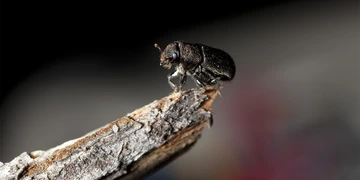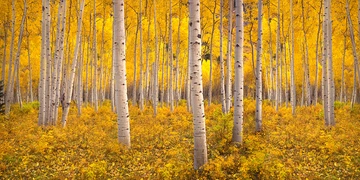Understanding and Fighting the Western Forest Firestorm
A University of Arizona fire ecology expert explains why each new wildfire season has been worse than the last — and what that might mean for the future.

Within the past decade, alarming footage of Western forest fires has become part of the daily news for a good part of the year. California’s 2017 Thomas Fire was the costliest on record. The Camp Fire, which burned 153,336 acres in Northern California in fall 2018, was the deadliest in the state’s history. In 2017–2018, fire suppression efforts led by the U.S. Forest Service cost more than $2.9 billion, more than 12 times what they did in 1985. According to NASA-funded RECOVER research, the majority of fires in the Western U.S. over the last six decades have occurred since 2000; there were no documented megafires (those burning more than 100,000 acres) before 1970.
University of Arizona professor Don Falk focuses on forests, fire ecology, and ecological restoration and resilience. Falk says the West’s current wildfire seasons are beginning to diverge from those of the past. The primary culprits: climate change, accumulating fuels and land use. As the climate gets warmer and drier, drought conditions create a surplus of the combustible fuel that forest fires feed on. Even a wet winter no longer helps tamp down fire danger. “In the long run, those wet periods produce a lot more fuel,” says Falk.
Warmer and drier summers don’t just increase fire fuel; they also exacerbate the intensity of forest fires and the difficulty in bringing them under control. “With a longer season, the fire has longer to burn, and the more time to grow. Ask any firefighter: Small fires can be put out or contained by humans, but big ones burn until the weather changes. The amount of heat they’re generating is so colossal, it’s like dropping a bomb.”
Indigenous People and Prescribed Burning
According to Falk, there’s another modern factor responsible for today’s record-setting fires: the suppression of the natural fire regime. Native Americans understood that wildfires were helpful in maintaining and extending grasslands, subsequently attracting game animals, and supplemented the natural fire regime with their own controlled burns in dry and moderately dry years. As Native Americans were moved off the land in the late 19th century, these cultural burning practices were halted, and instead of being kept under control in small surface fires, fuels of all kinds were left to keep growing.
Falk likens it to “stacking up more and more tinder for a bonfire.” The result is that when fires occur today, they are likely to be severe conflagrations.

The mountain pine bark beetle has devastated forests in the West.
Bugs in the Ecosystem
The combination of climate change and a longer wildfire season exacerbates another hazard to forests: insect damage. “Very few people know that insects affect forests more than wildfires,” says Falk. As winters become more moderate, insects that would have been inactive in cold weather can continue to thrive, feed and reproduce.
Trees that have been stressed by drought or damaged by fire can’t protect themselves as effectively, particularly against bark beetles, which gorge themselves on the growing tissues inside the tree. That means bouncing back from a wildfire becomes even more of a challenge.
Climate Change’s Role in Recovery
“After the TV cameras go home and the flames die down, the process of recovery begins,” says Falk. Historically, forests would eventually cycle back to their original character: First aspens would sprout up, eventually conifers would come back, and in 150 years, a forest would look much as it did before the fire. Today, however, “many forests are not going back to what they looked like, sometimes converting to a different ecosystem. Sometimes it’s minor, as with a forest with a different composition. Sometimes it converts to scrubland or grassland.”
An evolving ecosystem is nothing new, but the extreme transformations witnessed today appear to be unprecedented. As Falk explains, “The idea that things would convert from one thing to another isn’t shocking — it’s been happening for millions of years as ecosystems track changes in climate. But that was before rapid modern climate change entered the picture. As fires are getting bigger and more severe, a forest has to start all over again from seed. Dry, hot conditions are lethal to seedlings. The critical window comes after mature trees have died and the seeds don’t have a chance to survive. That’s the tipping point at which a forest ecosystem is unlikely to recover.”

Because of climate change, fires are getting bigger and more severe, and forests are less likely to recover.
Policy Possibilities
It’s a dire situation, but Falk says there are still measures we can take to ameliorate the damage. The first thing policymakers can do, he maintains, is to get serious about climate change. Otherwise, “you’ll increasingly have situations when forests can’t regrow. You’ll see more tree mortality because they’re weakened by drought. If we’re not getting serious about climate change, those seasons are going to get longer, and the fires will burn over larger areas.”
Another step we can take to preserve Western forests is permitting more prescribed burning, which allows fire back into the system without significant risk. “Reducing the amount of fuel that’s present is one of the few things than can moderate fires once they start.” Another tactic is out-planting seeds and seedlings in refugia, cooler and wetter areas where they might have a better chance.
But Falk insists that the best chance for preserving the West’s forest ecosystems lies with the next generation. “Training the next generation to be intelligent interpreters about the facts of climate change is critically important.” As the lead on the UA’s undergraduate degree in Global Change Ecology and Management, he takes an optimistic stance. “We want people coming out of college to understand what the problem is and to understand the tools they have. The highest priority for me is educating a new cadre of ecologists, post-climate change ecologists who can figure out creative ways to turn it around.”
